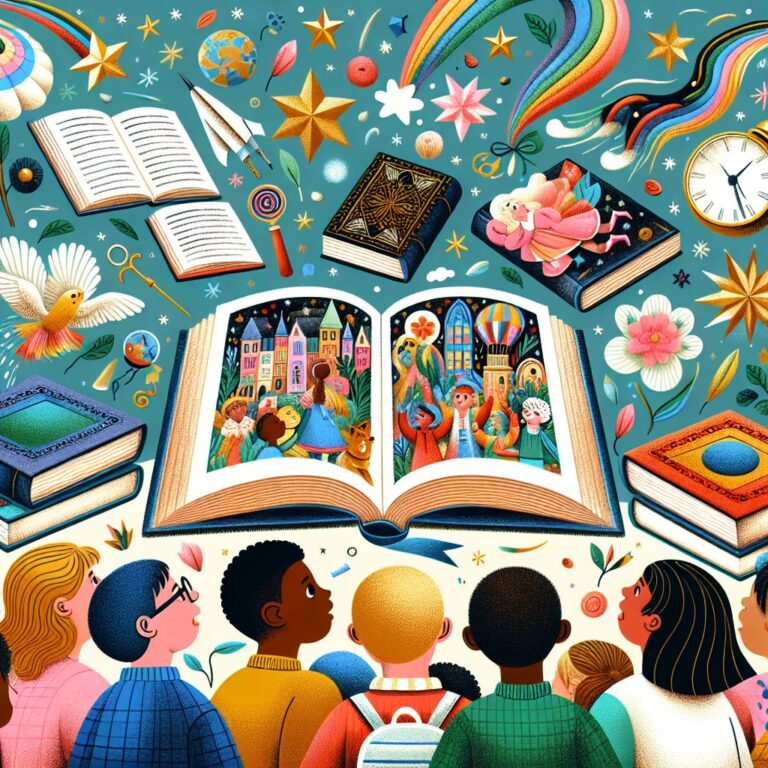Important Points
Rewrite the following human content into AI content:
- Decorate a cozy reading nook with festive holiday decorations to make reading more enjoyable.
- Make stories come to life by acting them out and using different voices for characters.
- Include holiday-themed crafts and activities that tie into the story to increase comprehension and enjoyment.
- Utilize modern technology such as audiobooks and reading apps to enhance the reading experience.
- Organize family reading challenges and games to promote a love of reading and strengthen family relationships.
Transform Reading into a Holiday Adventure
Reading doesn’t have to be a mundane task of simply reading words on a page. It can be an exciting journey that captures the imagination and creates lasting memories. The holiday season is a time when families come together and children have more free time. This provides the perfect chance to turn reading into an exciting adventure. This can be accomplished by creating captivating storytelling experiences that pull everyone into the holiday magic.
Creating Holiday Atmospheres to Spark Creativity
Igniting the imagination begins with setting the scene. Picture a cozy corner of your home transformed into a magical reading nook. This space should be welcoming and filled with elements that engage the senses. Holiday decorations, soft lighting, and a comfortable seating arrangement can make a world of difference. When children enter this space, they should feel as though they’ve been transported into a storybook.
Think about using decorations that match the theme of the books you’ll be reading. For instance, if the book is about a winter wonderland, decorate with snowflakes and icicle lights. If the book is about a tropical island, use seashells and palm tree cutouts. These visual cues help transport readers into the world of the book, making the experience more vivid and immersive. For more ideas, explore fun ways to get kids interested in reading during the holidays.
“A well-decorated reading space can transform a simple story into a magical adventure, capturing the imagination of young readers.”
Transforming Reading Into an Adventure for All Ages
Reading adventures aren’t just for kids. Adults can get involved too, turning the experience into a family affair. Choose stories that appeal to all ages, perhaps classics with universal themes or modern tales that everyone can enjoy. Discussing these stories together can open up conversations and deepen connections among family members.
If you want to turn reading into an adventure, consider how you can make the story come alive. This could mean acting out parts of the story, using props, or even making sound effects. The aim is to make the story seem real and thrilling, getting everyone involved and making sure they have a good time.
The Perks of Turning Stories into Adventures
Turning stories into adventures brings a lot of perks. It doesn’t only make reading fun but also boosts understanding and memory. When kids play an active part in the story, they’re more likely to grasp and recall what they’ve read. Plus, it encourages creativity, as they picture different situations and investigate different endings.
The Advantages of Engaging Storytelling
Engaging storytelling is an influential method that can alter how children view reading. When you make stories engaging, you establish an energetic learning setting that fosters involvement and inquisitiveness. This strategy inspires children to think analytically and inventively, as they delve into the story from diverse perspectives and contemplate various options. For more ideas, explore fun ways to encourage reading during the holiday season.
Boosts Comprehension and Retention
Children who take part in storytelling are not just sitting and listening, they’re actively involved. This participation aids in their comprehension and retention of the story. Whether they’re acting out a scene or talking about the story’s events, they’re bolstering their understanding and forming a stronger bond with the story.
Interactive storytelling also urges children to ask questions and look for answers, which boosts their comprehension. When they discuss the story with others, they hear different viewpoints and ideas, which can help them understand the story better and remember it longer.
Illustrating Beloved Moments
Urging kids to illustrate their most loved moments from a tale is a wonderful method to strengthen their bond with the content. This task enables them to picture the storyline, rendering it more solid and unforgettable. Through illustrating, they interact with the narrative on an imaginative plane, which may boost their comprehension and recall.
Begin by giving the kids some art materials like colored pencils, markers, and paper. Have them pick a scene that really stuck with them and recreate it in their own way. This not only helps them understand the story better but also lets them express their own take on the story.
Turning Inspiration into Laughter
Laughter is a great way to make reading more fun and engaging. Encourage kids to come up with jokes based on the stories they read. This activity can help them develop their sense of humor and creativity while reinforcing their comprehension of the story. For more ideas on how to make reading an adventure, check out how to inspire reading in children.
Begin with a conversation about the hilarious parts or personalities in the tale. After that, have the kids brainstorm their own jokes or amusing situations based on these components. Sharing these jokes with family members can lead to a lot of laughter and a lively environment, making the reading experience unforgettable. For more ideas on how to inspire children, consider these ways to inspire adventure and reading in children.
Using Technology to Modernize Storytime
- Introduce your children to audiobooks and e-books to give them more ways to read.
- Use interactive reading apps to get your kids excited about reading with multimedia content.
- Set up virtual storytime sessions with family or friends to make reading a shared experience.
Technology gives us new ways to make reading exciting. By using digital tools, you can make stories more interactive and engaging, which is great for kids who love technology. Whether you use audiobooks, e-books, or interactive apps, technology can help you make stories come alive in new and exciting ways.
For example, audiobooks can be a wonderful choice for children who have difficulty with conventional reading or for those who love hearing stories. They can hear a professional narrator make the story come alive, replete with sound effects and music. This can be especially helpful for auditory learners who learn more effectively by listening.
Interactive reading apps provide a multi-sensory experience by blending words, pictures, and sounds to craft a captivating story world. These apps frequently have interactive elements such as quizzes, games, and animations that can strengthen understanding and make reading more enjoyable.
Use Audiobooks and E-Books
Audiobooks and e-books are great for giving kids a variety of ways to read, depending on their learning style and preferences. Audiobooks are especially good for letting kids listen to a story while they’re doing something else, like riding in the car or drawing. They also help kids learn new words and how to pronounce them.
On the flip side, e-books offer interactive features that make reading more enjoyable and accessible. You can adjust the text size, use built-in dictionaries, and take notes. Plus, many e-books include interactive elements like animations and sound effects that can bring stories to life.
Interactive Reading Apps
Interactive reading apps are a great way to make reading more fun and engaging. These apps often include multimedia content such as videos, animations, and sound effects that can bring stories to life. They also offer interactive features like quizzes, puzzles, and games that reinforce comprehension and make learning fun.
When you’re picking a reading app, make sure to find one that matches your kid’s interests and reading level. A lot of apps have a huge variety of stories, from old classics to new adventures, so there’s bound to be something for every reader. Plus, some apps have progress trackers and reward systems, which can encourage kids to read more.
With the help of these apps, you can transform your reading routine into a lively and engaging storytelling experience that grabs the attention of kids and fosters a passion for reading.
Set Up Online Reading Parties
Online reading parties are a fantastic method to stay in touch with family and friends, especially when you can’t meet in person. By setting up virtual story times, you can share tales and conversations with the people you care about, regardless of where they are located.
For a fun virtual storytelling experience, pick a video conferencing tool that everyone can use. Choose a story that will appeal to everyone and take turns reading out loud. Encourage everyone to share their thoughts and interpretations to foster a sense of community and connection through shared storytelling.
Organize a Family Reading Challenge
Organizing a family reading challenge is a fun way to turn reading into a shared journey. This activity involves setting reading goals and challenges that the whole family can take part in. By working together to achieve these goals, you create a sense of camaraderie and achievement. For more ideas, check out these fun ways to encourage reading during the holiday season.
First, set a group reading goal, like reading a set number of books by the end of the holiday. Then, come up with a list of challenges or activities that go along with each book, like drawing a scene, acting out a chapter, or writing a summary. These activities help get kids excited about reading and help them understand the story better.
Reading Challenges for Everyone
Reading challenges can be a fun way to motivate readers of all ages. You can tailor these challenges to suit different reading levels and interests, so everyone can join in. For instance, you could challenge younger kids to read a certain number of picture books, while older kids and adults could take on chapter books or novels.
Planning Story Adventures
Planning story adventures adds a sense of discovery to reading. Design a map or timeline of the story’s events, emphasizing important locations and plot developments. This visual tool can assist readers in comprehending the story’s progression and remembering significant details.
Talking About the Story Afterwards
Chatting about the story after reading it can help everyone understand it better and think more critically. Ask your family what they thought about the story and what they think about the themes, characters, and events. This gives everyone a chance to see the story from different points of view and understand it in different ways, which makes reading more fun. For more ideas, consider creating a family story time tradition for the holidays.
Spice Things Up with Fun Games and Contests
Reading can be made more exciting and interactive through games and contests. Adding these activities to your reading schedule can create a fun and lively atmosphere that promotes involvement and cultivates a passion for reading.
Trivia Games Based on Stories
Trivia games that are based on stories can be a fun way to test the knowledge and comprehension of the reader. You can create a list of questions that are related to the plot of the story, the characters in the story, and the themes of the story, and then challenge your family members to answer them. This can be a fun way to reinforce understanding and to encourage attention to detail. For more ideas on how to make reading fun, check out this article on making reading fun during holiday time.
Fun-Filled Joke-Telling Contests
Joke-telling contests are a lively way to bring some humor into your reading routine. Encourage your family members to think up jokes that are inspired by the story and share them with each other. This activity can inspire creativity and make the reading experience a lot more fun. Discover why kids who read joke books are more confident and creative.
Furthermore, these competitions can also help foster self-confidence and communication skills, as participants get the chance to practice presenting their jokes to an audience.
Engaging Story-Driven Games
Engaging story-driven games can make stories feel alive in ways that are new and thrilling. Role-playing, problem-solving, and decision-making are often involved in these games, enabling participants to dive into the world of the story. Playing these games allows readers to build their critical thinking and teamwork abilities while enjoying themselves.
Promote the Creation of Personalized Stories
Creating personalized stories is a creative endeavor that enables readers to become authors and storytellers. Children can express their thoughts and creativity by creating their own stories, which also helps them improve their writing and storytelling abilities.
First, inspire the kids to come up with ideas for their stories, like the characters, the settings, and the plotlines. Offer some direction and assistance as they flesh out their narratives, aiding them in honing their ideas and organizing their stories.
- Encourage kids to write and illustrate their own holiday stories.
- Give them journals or notebooks to document their creative ideas and inspirations.
- Encourage collaboration by involving family members in the storytelling process.
Creating Personal Holiday Stories
Creating personal holiday stories allows kids to use their experiences and imagination to create unique stories. This activity can be especially meaningful during the holiday season, as kids reflect on their traditions and memories.
Keeping a Journal of Creative Ideas
Having a journal to keep track of creative thoughts and inspirations is a useful tool. Encourage children to have a journal where they can write down ideas for stories, character sketches, and plot outlines. This habit can help them organize their thoughts and improve their storytelling abilities.
Moreover, diaries give kids a place to think about their reading adventures and jot down their ideas and feelings about the tales they’ve enjoyed.
Children can monitor their progress and observe the evolution of their storytelling abilities by writing their thoughts down in journals.
“Getting kids to jot down their imaginative thoughts in a diary can help them improve their ability to tell stories and articulate their creativity.”
Storytelling as a Family Activity
Storytelling as a family activity can foster a sense of togetherness and cooperation. Encourage each family member to participate in the storytelling process by adding their own thoughts and viewpoints. This cooperative activity can promote communication and creative thinking, and can lead to the creation of a one-of-a-kind, unforgettable story.
Make it Funny with Joke Books
“Adding a touch of humor to reading time can make it more fun and engaging for everyone involved.”
Adding joke books to your reading routine can be a fun and entertaining way to change things up from traditional stories. These books usually contain a variety of jokes, riddles, and funny stories that can make reading time a lot more enjoyable.
Adding a touch of humor to your reading activities can create a fun and engaging environment that encourages participation and cultivates a love for reading.
Additionally, joke books can be used to improve language skills and creativity, as readers learn new ways to express humor and wit.
Include Fun Breaks
Fun breaks can be a delightful and engaging addition to your reading schedule. Include short joke breaks or amusing stories between reading activities to keep the atmosphere relaxed and fun. These breaks can help keep interest and make the reading experience more fun for everyone involved.
Add Humor to the Story
By adding jokes to the story, you can make the reading experience more fun and enjoyable. This can keep children engaged and entertained, and it can also help them develop their language skills and creativity. This is because they will learn to appreciate and create humor within the context of a story. For more insights, check out 5 reasons to include humor in your child’s reading routine.
Fun Joke-Reading Time
Interactive joke-reading time can be an enjoyable and engaging way to add humor to your reading routine. This can involve reading jokes out loud, discussing their meanings, and even making new jokes inspired by the story. By making jokes a part of the reading experience, you can foster participation and a love for reading.
For an interactive joke-reading segment, choose a few jokes from a joke book or create your own based on the story. Then, gather family members or friends and take turns reading the jokes aloud. Encourage everyone to share their thoughts and reactions, discussing what makes each joke funny and why.
Moreover, you can encourage participants to create their own jokes, drawing inspiration from the story. This activity can foster creativity and language skills, as readers experiment with various ways to convey humor and wit.
- Ask participants to share their favorite jokes and discuss what they mean.
- Encourage readers to come up with new jokes inspired by the story.
- Use jokes to make reading sessions more fun and keep readers engaged.
Encourage Both Independent and Group Reading
Encouraging both independent reading and group reading can help to foster a love of reading and improve reading skills. By providing opportunities for both independent and group reading, you can cater to different tastes and learning styles, making sure that everyone can enjoy the benefits of reading.
Choose-Your-Own-Adventure Stories
Choose-your-own-adventure stories enable readers to navigate stories at their own speed and based on their own interests. This method can foster independence and self-drive, as readers take the reins of their reading journey and decide for themselves what to read and when. For more ideas on encouraging reading habits, explore 5 reasons to include humor in your child’s reading routine.
For self-led storytelling adventures, offer an array of reading materials and urge readers to pick stories that they find appealing. Make a reading log or journal where they can monitor their progress and jot down their thoughts and feelings about the stories they read.
Arrange Collective Storytime Gatherings
Collective storytime gatherings can cultivate a feeling of togetherness and bonding among participants. By scheduling regular storytime gatherings with loved ones or pals, you can encourage cooperation and conversation, enabling participants to express their ideas and understandings of the tales they read.
While reading together, take turns reading out loud and talking about the themes, characters, and events in the story. Encourage everyone to ask questions and share their thoughts. This creates a fun and engaging reading environment that also helps develop critical thinking and communication skills.
Start a Book Club with Family or Friends
Starting a book club with family or friends is a fantastic way to promote reading and conversation. You can choose a book to read as a group and have regular meetings to talk about it. This creates a sense of responsibility and motivation, as well as a shared reading experience that promotes connection and comprehension.
If you’re thinking about starting a book club, the first thing you need to do is pick a book that everyone will enjoy. Then, set a timetable for when you’ll read the book and when you’ll talk about it. At your meetings, make sure everyone feels comfortable sharing their opinions about the book. This will help everyone understand the book better and enjoy it more. Plus, it’s a great way to build stronger friendships with the other people in your book club.
Let’s Celebrate Reading!
It’s important to celebrate the journey of reading. This can create a sense of achievement and motivation for readers. When you acknowledge the milestones they’ve reached, you can encourage them to keep reading. This can foster a lifelong love of literature.
Celebrate Achievements
Recognizing and rewarding readers’ efforts and progress by celebrating achievements can be a powerful motivator. Whether it’s finishing a book, meeting a reading goal, or taking part in a reading challenge, these milestones can instill a sense of pride and motivation to keep reading.
Throw a little party or get-together to celebrate the accomplishment. Share the best parts of the reading journey, talk about what you learned, and thank everyone for their hard work and input.
End-of-Book Holiday Celebrations
End-of-book holiday celebrations can be a fun and memorable way to celebrate the end of a reading journey. These parties can include themed decorations, activities, and treats that align with the story, creating a festive and engaging atmosphere that encourages reflection and discussion.
At the party, ask everyone to talk about their favorite parts of the story, what they learned, and what they think about the story. This party can help everyone understand the story better, appreciate the story more, and make good memories and friendships with each other.
Acknowledging Achievements with Certificates
Acknowledging achievements with certificates can provide a concrete way to recognize and celebrate readers’ accomplishments. By designing customized certificates that celebrate individual achievements, you can foster a sense of pride and motivation for continued reading.
Think about creating awards that honor various parts of the reading adventure, like finishing a set number of books, taking part in a reading competition, or showing growth in reading abilities. Give out these awards during a party or get-together, showing gratitude and support for each reader’s hard work and advancement.
Final Thoughts
Transforming holiday tales into adventures is a brilliant method to make reading more interactive and fun for the whole family. By developing interactive and immersive storytelling experiences, you can encourage a love for reading and improve literacy skills for readers of all ages.
Recap on Engaging Strategies
In this article, we’ve been discussing a variety of strategies to make reading fun and adventurous. Whether it’s creating a magical reading space, using interactive storytelling techniques, or engaging with crafts, technology, and games, these strategies can change the way we read and create lasting memories.
Get Started with These Ideas
Why not give these tips a try? Feel free to adapt them to your family’s unique tastes and interests. When you turn reading into a shared adventure, you’re building connections and creating joy. And you’re fostering a lifelong love of books.
Introduce Joke Books Series for More Laughs
For more laughs, think about adding joke books to your reading list. These books can offer a fun and amusing break from regular stories, making reading even more enjoyable and funny.
Injecting a bit of laughter into your reading activities can help create a fun and dynamic environment that encourages involvement and cultivates a passion for reading. Discover reasons to include humor in your child’s reading routine to make it more engaging.
Take Advantage of Seasonal Book Deals
Bookstores and online retailers often have special sales and promotions on books during the holiday season. Use these deals to grow your book collection and find new stories and adventures to share with your family.
Questions You May Have
Here are some questions and answers you might find helpful for your reading journey:
What are some tips for acting out stories?
When acting out stories, try to use your body and voice to make the characters and the story more lively and real. Let everyone try different characters and situations to make the story more creative and engaging. Most importantly, have fun and enjoy the process of bringing the story to life.
How does technology improve reading?
Technology improves reading by offering interactive and multimedia content that makes stories come alive. Audiobooks, e-books, and reading apps provide flexible and exciting options for readers, accommodating different tastes and ways of learning. By integrating technology into your reading routine, you can build a vibrant and engaging storytelling atmosphere. For more ideas, explore fun ways to encourage reading during the holiday season.
What kind of crafts work well with holiday stories?
- Themed crafts that tie into the story, like making decorations or props.
- Illustrating or painting scenes from the story to help visualize the plot.
- Making character masks or costumes for pretend play.
These crafts can help solidify understanding and make reading more hands-on and fun.
By adding these tips and exercises into your reading plan, you can make a fun and engaging atmosphere that encourages a love for reading and improves literacy skills for the whole family.







One Comment